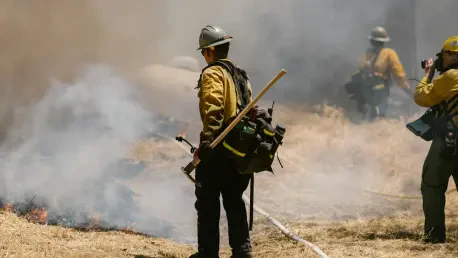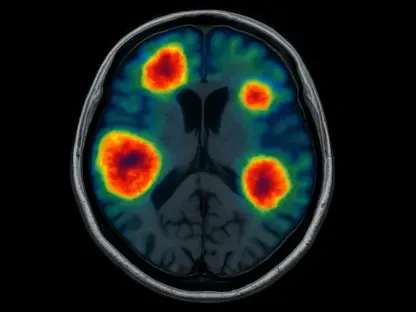Recent studies have illuminated critical insights into the long-term health risks associated with exposure to wildfire smoke, particularly its implications for the human cardiorespiratory system. As wildfires become more frequent and intense due to climate change, understanding these risks is paramount for both public health and policy-making. Wildfire smoke comprises fine particulate matter, specifically PM2.5, which is known for its ability to penetrate deep into the lungs and even enter the bloodstream, exacerbating a range of cardiovascular and respiratory conditions. Investigations led by renowned institutions like the Icahn School of Medicine and Harvard T.H. Chan School of Public Health reveal not just the immediate dangers but the lasting impacts that persist well beyond the smoke’s dissipating presence. This underscores a call for comprehensive strategies addressing these ongoing health challenges, ensuring communities are better prepared and protected against such environmental hazards.
Insights From Recent Research
Research on the impact of wildfire smoke exposure has provided significant revelations regarding its medium- and long-term health effects on the cardiorespiratory system. The focus is chiefly on PM2.5, the tiny particulate matter prevalent in wildfire smoke, which carries profound risks to human health. Unlike other forms of particulate matter, wildfire-specific PM2.5 tends to be enriched with harmful carbonaceous compounds, known to incite oxidative stress and inflammation in the body. This heightened toxicity poses a more acute risk compared to conventional PM2.5 sources. Recent studies have established a link between wildfire smoke exposure and increased hospitalizations due to several cardiovascular and respiratory ailments, including ischemic heart disease, cerebrovascular disease, and chronic obstructive pulmonary disease (COPD), among others. A notable finding is the pronounced escalation in hypertension cases correlated with prolonged exposure to PM2.5 from wildfire smoke.
Another substantial breakthrough is the identification of specific vulnerable populations facing disparate impacts from wildfire smoke exposure. Communities with extensive vegetation or lower socioeconomic status, alongside individuals with a smoking history or pre-existing health conditions, were found to be at a heightened risk of adverse health outcomes. These findings emphasize the importance of devising targeted interventions aimed at safeguarding these high-risk groups. The revelations also underscore the necessity for enhancing public awareness and education about the staggering health consequences posed by wildfire smoke. By fostering an informed public and equipping healthcare professionals with a nuanced understanding, efforts to mitigate health risks can be more strategically aligned, ultimately reducing the burden on public health systems.
Methodological Advances
The research leveraged advanced methodological approaches to ensure robust and credible findings. A particularly novel aspect was the utilization of a self-controlled case series design within the research framework, enabling scientists to study the participants accurately by comparing their health outcomes over time. This method effectively counteracted the influence of slow-changing variables, such as genetic predispositions, that could skew results. By focusing on self-comparison, the study managed to isolate the specific health effects attributable to PM2.5 exposure, producing clear, unbiased insights. The innovative design improves the precision of conclusions, elevating the reliability of the research in delivering impactful evidence about the health impacts associated with wildfire smoke.
This meticulous approach underscores the significance of adopting dynamic and adaptable research methodologies to unravel complex environmental health challenges. By incorporating evolving scientific techniques, this study sets a precedent, encouraging other researchers to integrate similarly innovative designs in future inquiries. Such endeavors are crucial in enhancing the breadth and depth of understanding regarding environmental health risks in a world facing escalated wildfire incidents. This evidence-based narrative supports advocacy for well-informed policy formation and execution, ensuring effective management of public health responses to growing wildfire occurrences.
Emerging Trends and Public Recommendations
The increasing frequency and intensity of wildfires have sparked an urgent reevaluation of current wildfire management and public health safeguarding strategies. Experts emphasize that traditional approaches, largely focusing on property protection and fire suppression, fall short in addressing the comprehensive health impacts of wildfire smoke. The call for innovative, health-centered strategies is growing louder, signifying a shift in focus to prioritize human health outcomes in wildfire management policies. This evolving discourse proposes an expanded scope of prescribed burning practices, integrating not only land management but also proactive health protection measures. Such adaptive strategies are crucial as communities navigate the multifaceted challenges posed by shifting climate dynamics and escalating wildfire threats.
Public health recommendations strongly advocate for preventive measures to mitigate health risks during and following wildfire events. The usage of high-efficiency particulate air (HEPA) filters and respiratory protective gear, such as masks, is emphasized to minimize respiratory particulate matter intake. These measures are vital, given studies highlighting the persistence of fine particulates even after wildfires are extinguished. Another pivotal recommendation is the enhancement of public information campaigns to increase awareness of the symptoms and risks associated with smoke inhalation, complemented by guidance on recognizing and responding to health threats swiftly. These initiatives strive to equip communities with the knowledge and resources necessary to navigate wildfire events more safely, ensuring collective health resilience.
Strategic Directions for the Future
Research on wildfire smoke’s impact has revealed significant insights into its medium- and long-term effects on the cardiorespiratory system, especially focusing on PM2.5. This tiny particulate matter found in wildfire smoke poses significant health risks. Wildfire-specific PM2.5 is enriched with harmful carbonaceous compounds, causing oxidative stress and inflammation, making it more toxic than conventional PM2.5. Studies link exposure to increased hospitalizations due to issues like ischemic heart disease, cerebrovascular disease, and COPD. Notably, there’s a rise in hypertension cases associated with prolonged exposure. Vulnerable groups include those in vegetated areas or with low socioeconomic status, as well as people with smoking habits or pre-existing conditions. The findings highlight the need for targeted interventions and enhanced public awareness. Educating the public and healthcare professionals is crucial in reducing the burden on public health systems and implementing effective risk mitigation strategies.









